
Figure: This cross-eyed stereopair shows a sample object
from relativistic string theory: world sheet. Arrow points
to physical singularity (4D pinch point).

Towards the Distributed Virtual Education and Training Environment
by Igor Nikitin, Valery Burkin and Stanislav Klimenko
Interactive installations in a virtual environment, supporting the educational process, are created at GMD Institute for Media Communication. Each installation is reflected in the Internet as an introductory course to correspondent discipline. Related video-films, recorded in a virtual environment, are offered as illustration material.
The modern educational processes actively uses the methods of computer graphics and scientific visualization. Wide opportunities are opened by the emerging technology of virtual environments, which can be used for the creation of highly interactive virtual laboratories intended for teaching different disciplines. GMD’s Institute for Media Communication participates in the INTAS project ‘Visualization of Complex Physical Phenomena and Mathematical Objects in Virtual Environment’, supporting the development of virtual laboratories in natural sciences. Three installations are currently created in GMD’s immersive virtual environment system CyberStage, serving education in higher mathematics, theoretical physics, astronomy and astrophysics.
Topological Zoo
This installation demonstrates the main properties of elementary topological objects (Moebius band, Klein bottle, projective plane etc.) and gives the possibility to explore interactively these complex constructions arising in higher mathematics. The installation is accompanied by a web-tutorial on the topology of low dimensional manifolds, introducing all necessary concepts, and illustrated by 3 video-films.
In the Microworld
This is an elementary introduction to a theory of relativistic strings, a branch of theoretical physics, exploring the properties of elementary particles. String theory is selected due to its increasing popularity among the theorists and because it accumulates almost the whole mathematical apparatus used in modern theoretical physics. To attend this Internet-course, no special pre-requisites are needed, except 1st year University lectures on higher mathematics. The course includes a lot of graphical material, particularly, stereoscopic movies in the form of stereopairs and anaglyphs. Several applications on visualization of string dynamics are available, playing the role of interactive practicum. The course is also supported by an installation in CyberStage. It is a prototype for a virtual lecture room of the future, where complex animated 3D forms, created by theoretical physics, can be directly observed and interactively studied. The related course material can be displayed on virtual screens using virtual slide projectors.
Virtual Planetarium
Experimental course on basics of astronomy, delivered inside the immersive virtual environment system, and describing interactively all surrounding astronomical objects (planets, constellations, stars, nebulae etc). Currently the installation includes 3D models of 30 objects in the Solar System, 3200 nearby stars, a large database, containing textual descriptions of all the objects in a scene, interactive map of constellations and tools for search and navigation.
Applications
The described courses and videos were used in the educational process at Moscow Institute for Physics and Technology, University of Helsinki, University of Kaiserslautern and other educational institutions in Europe and USA. Virtual laboratories in GMD’s high-end immersive virtual environment systems were presented at several local and remote exhibitions, students and scholar excursions.

Figure: This cross-eyed stereopair shows a sample object
from relativistic string theory: world sheet. Arrow points
to physical singularity (4D pinch point).
The content of virtual laboratories can be integrated to Internet-accessible library of components, where the teacher can get the objects necessary for presentation. All applications can be adapted to simpler projection systems for demonstrations on the screen of the University’s lecture hall or the wall of real planetarium.
Links:
Introductory course on string theory: http://viswiz.gmd.de/~nikitin/course
Tutorial on topology of low dimensional manifolds: http://viswiz.gmd.de/~nikitin/vismat_html
Virtual Planetarium in CyberStage: http://viswiz.gmd.de/~nikitin/stars/starsCB.html
Related research projects: http://viswiz.gmd.de/~nikitin/viz.html
Please contact:
Igor Nikitin - GMD
Tel: +49 2241 14 2137
E-mail: Igor.Nikitin@gmd.de